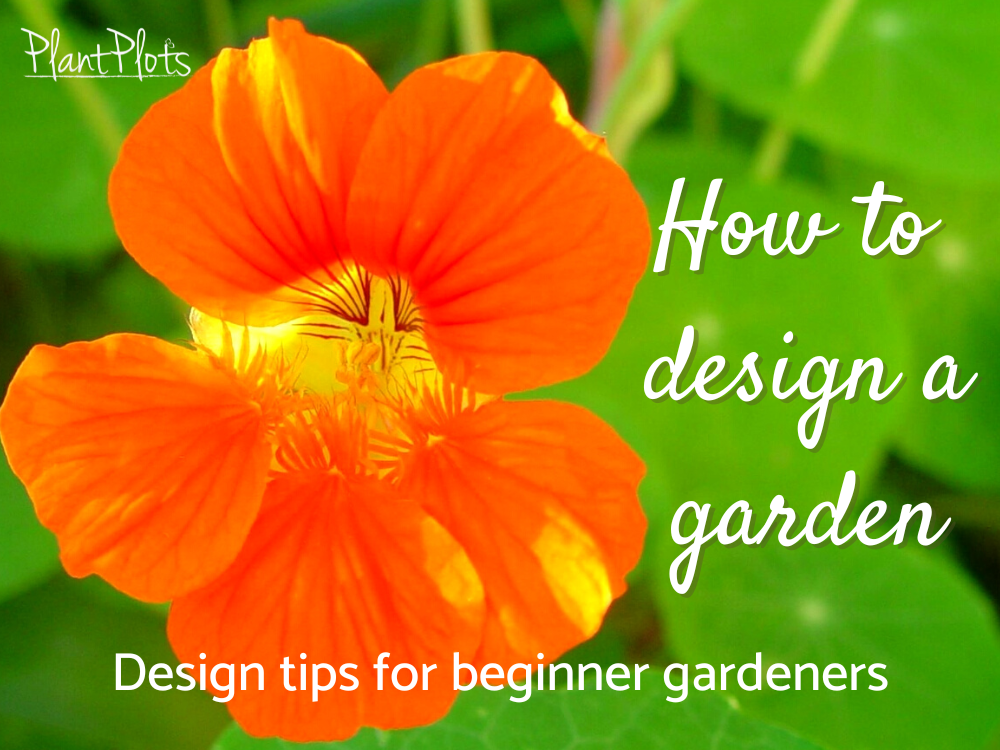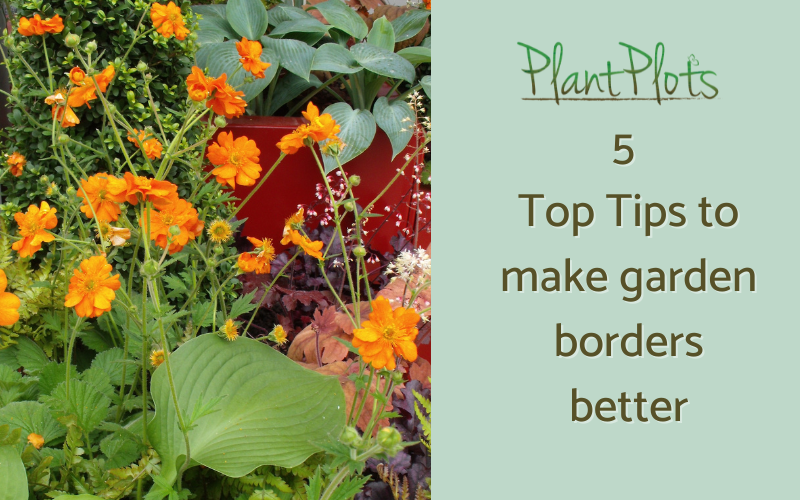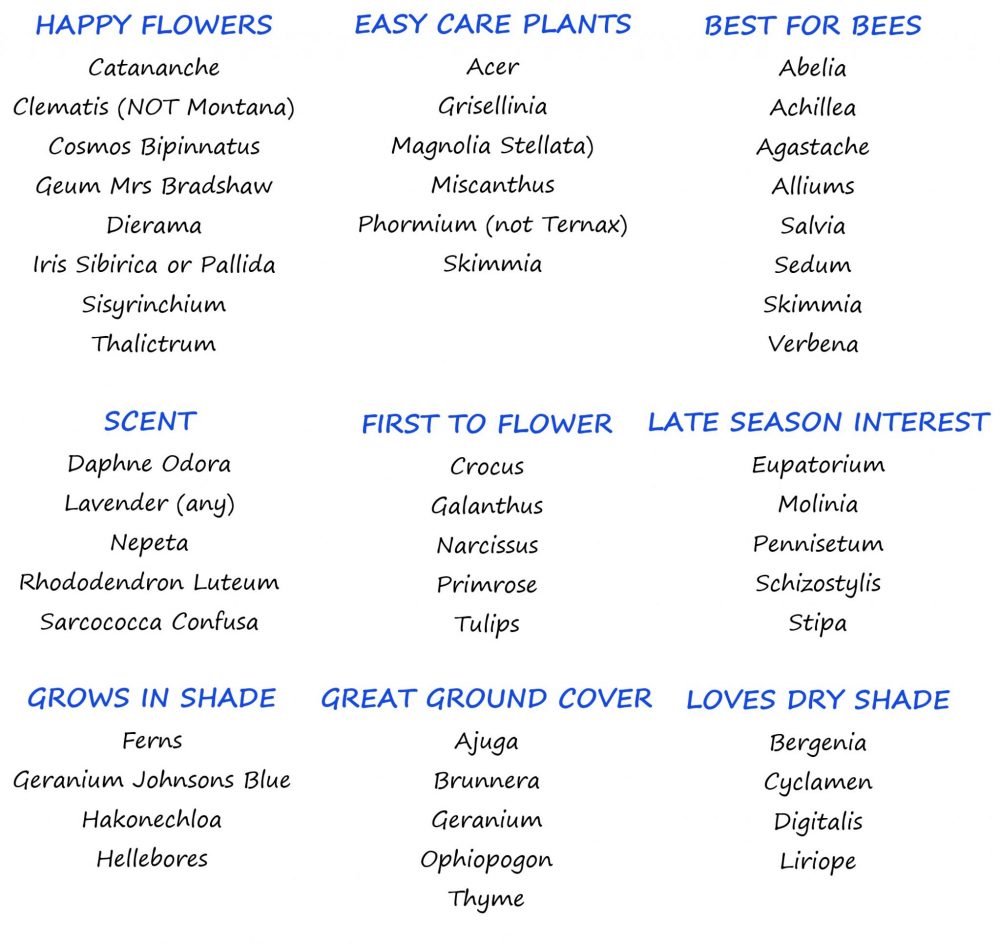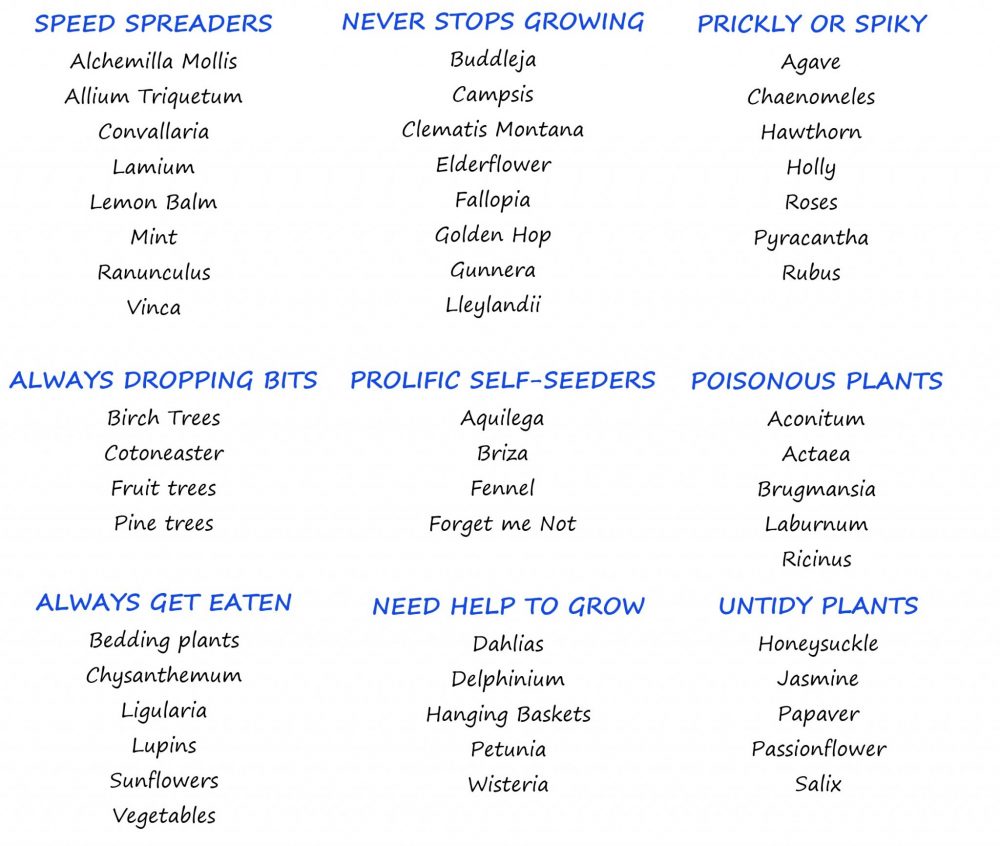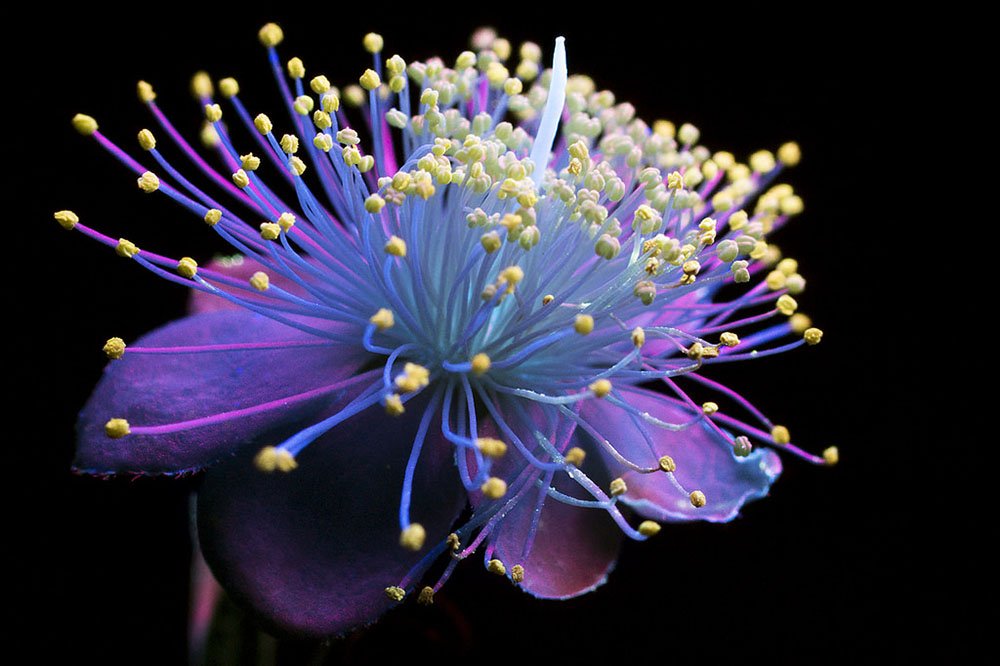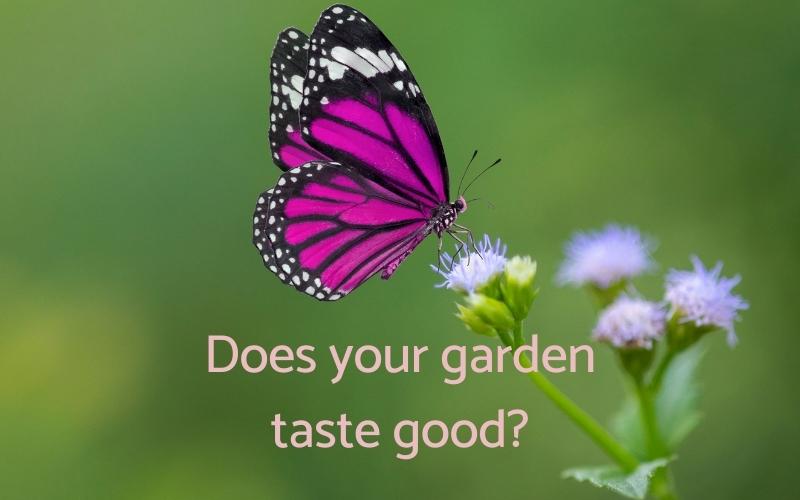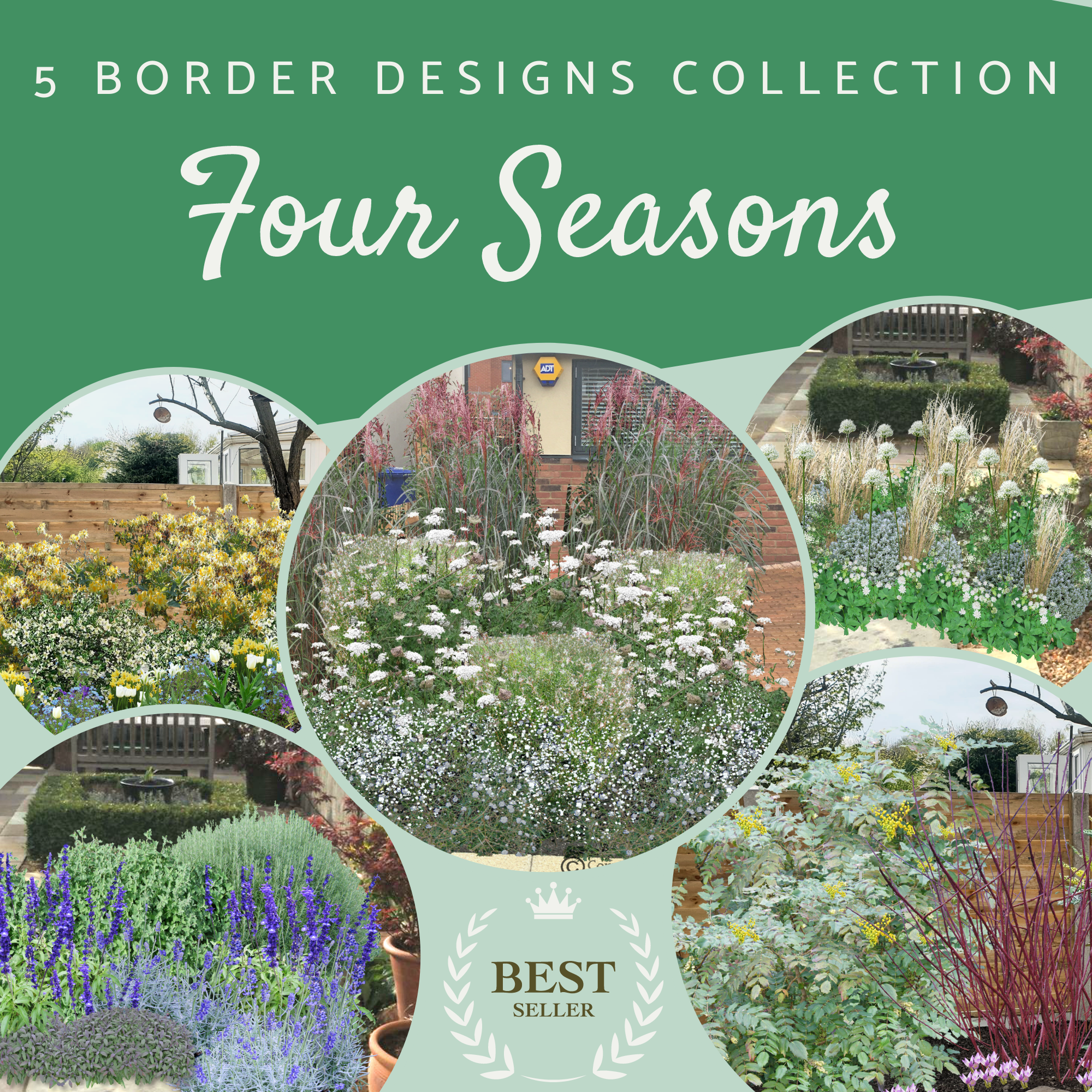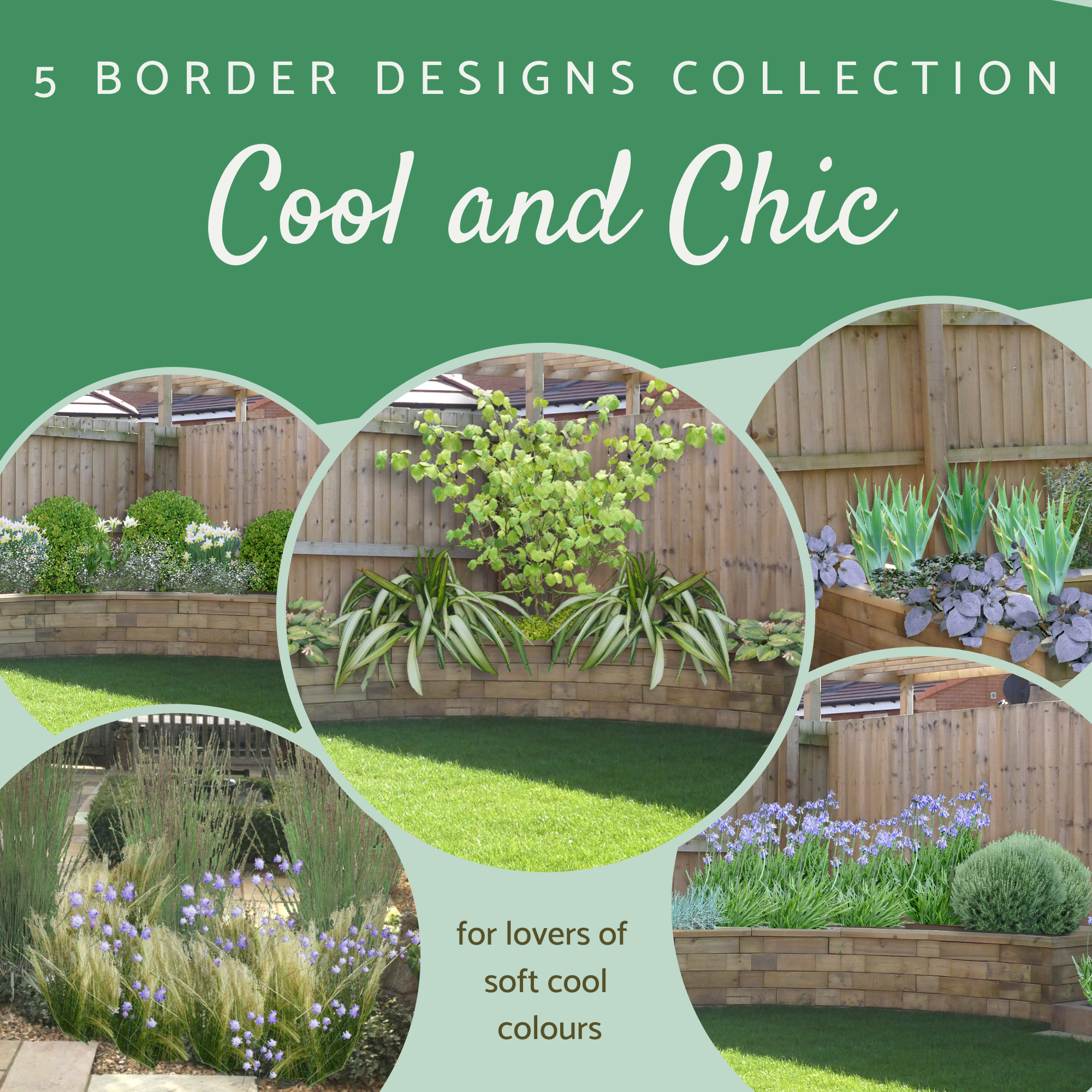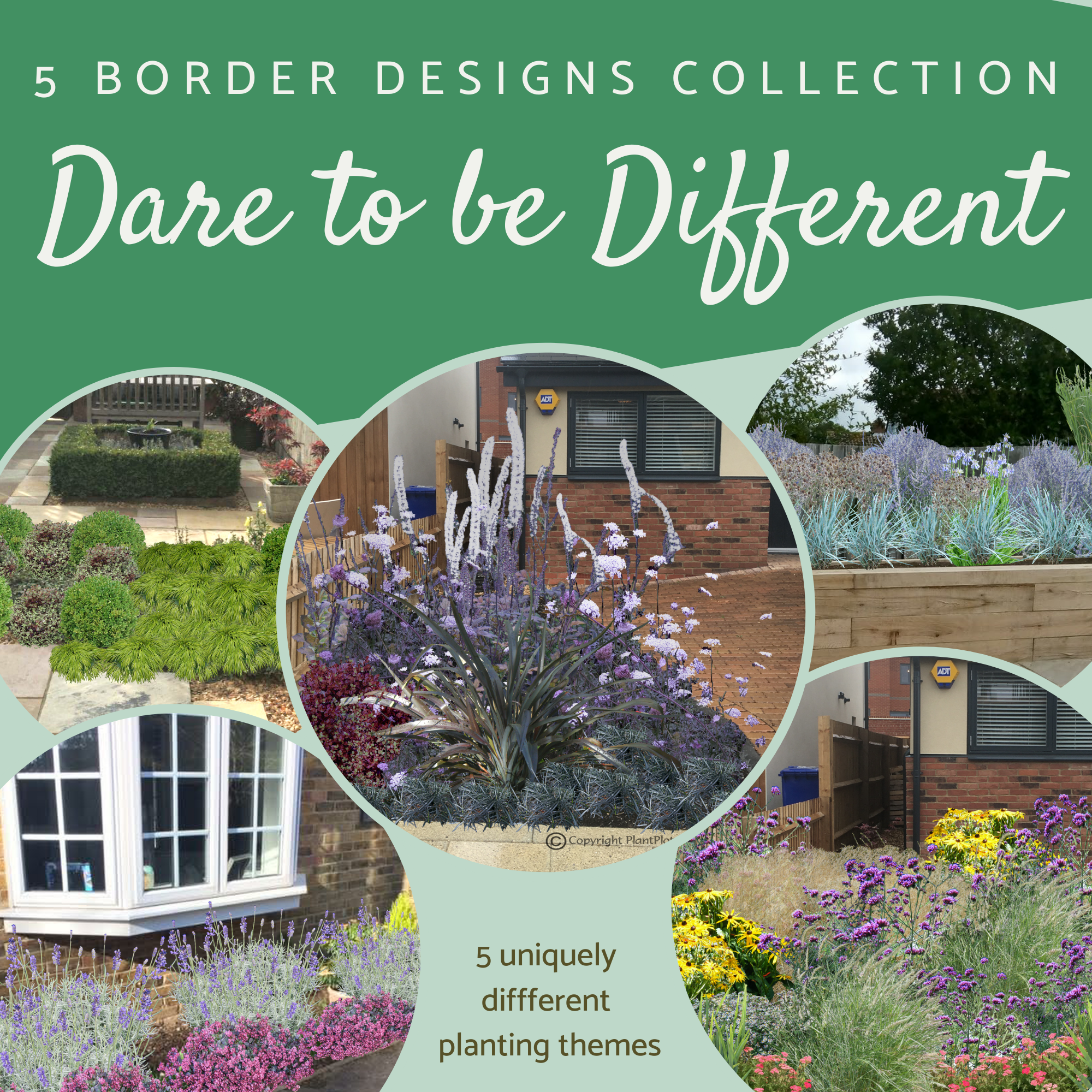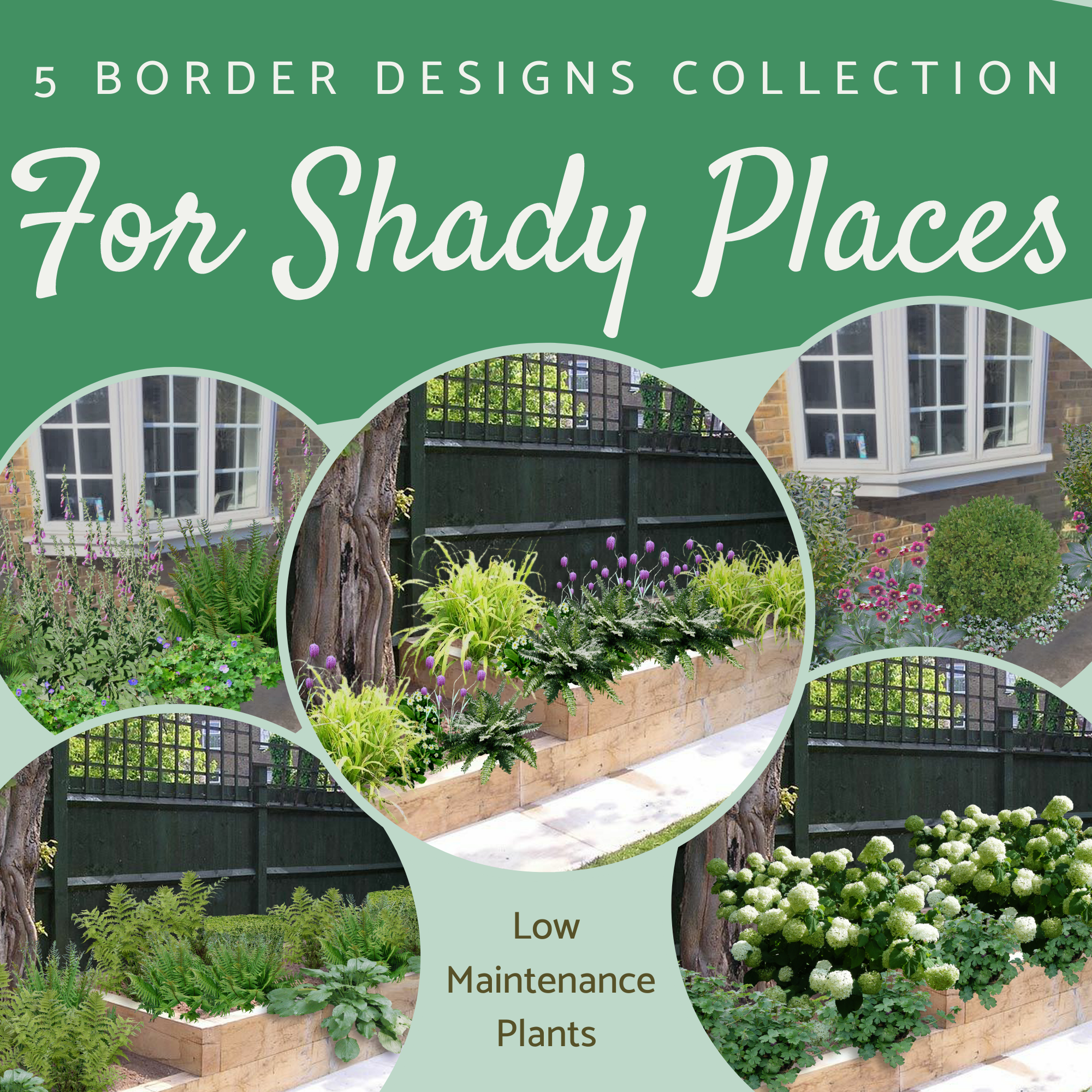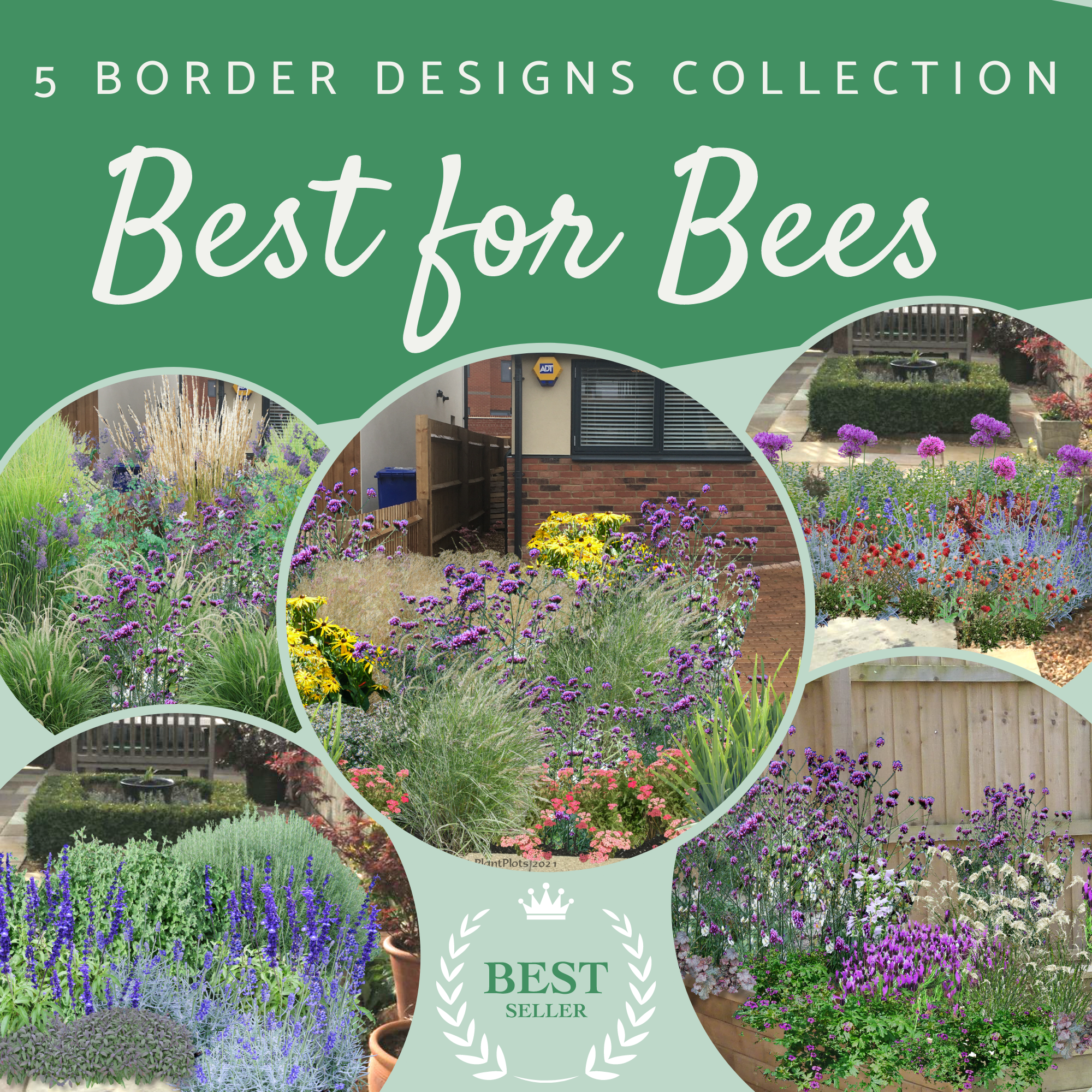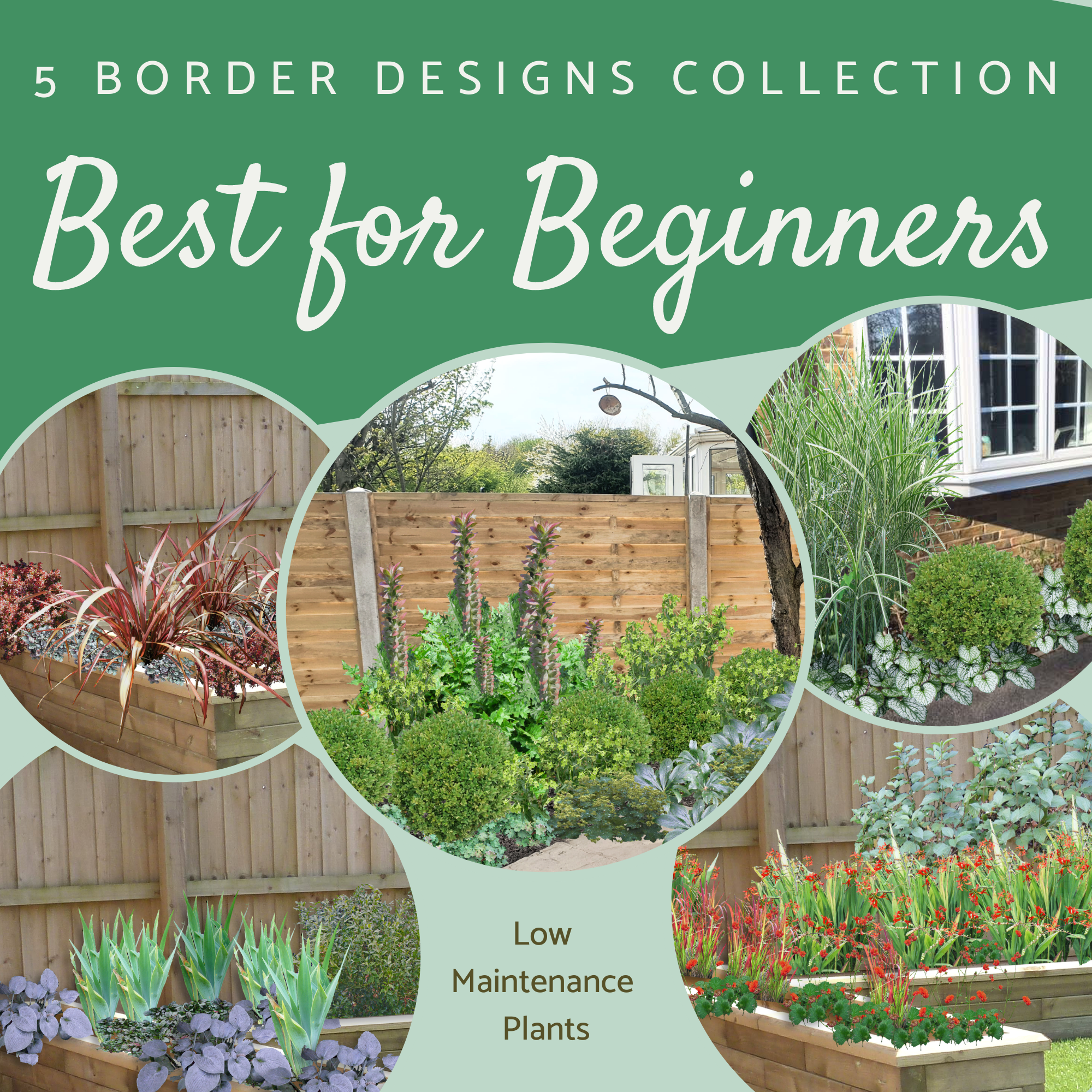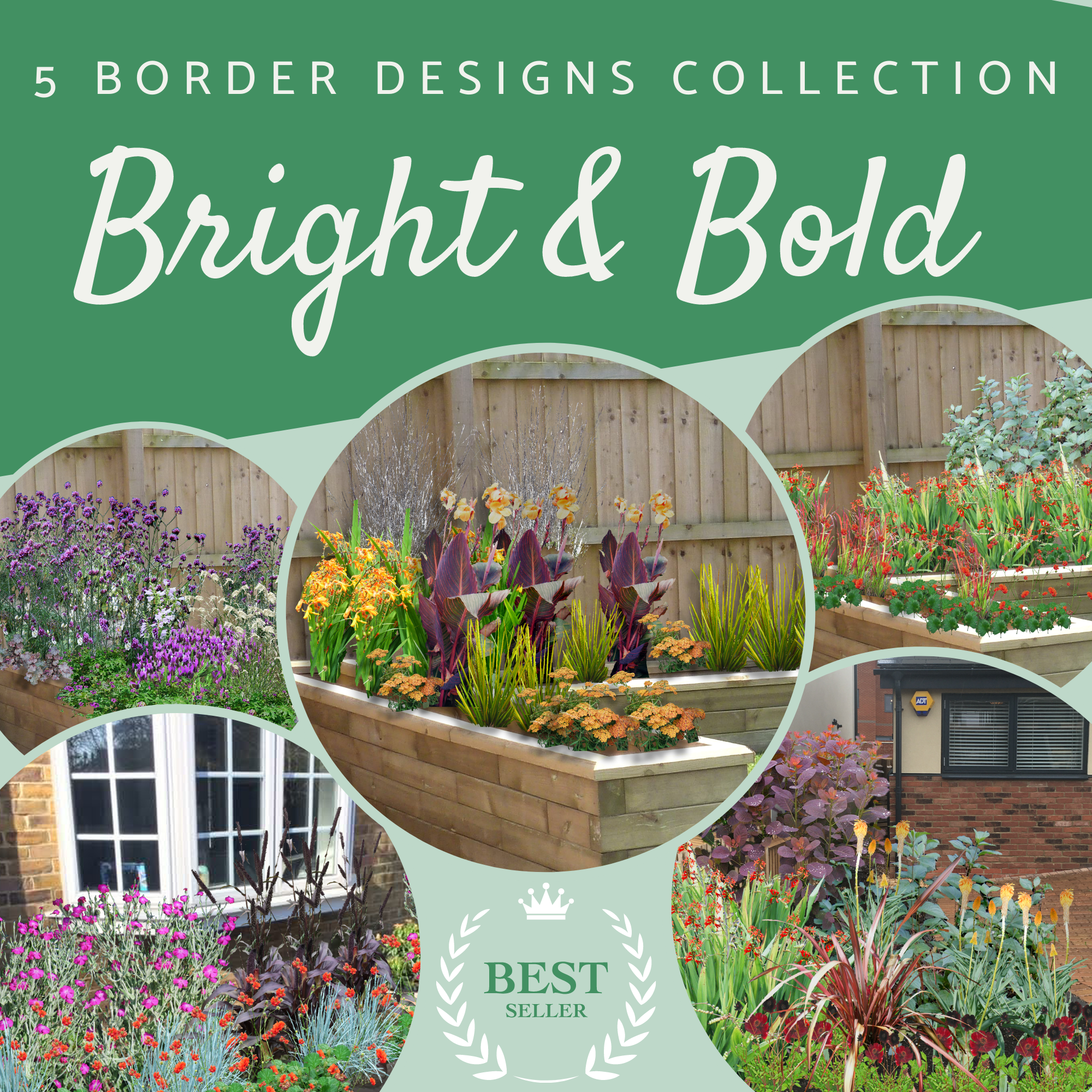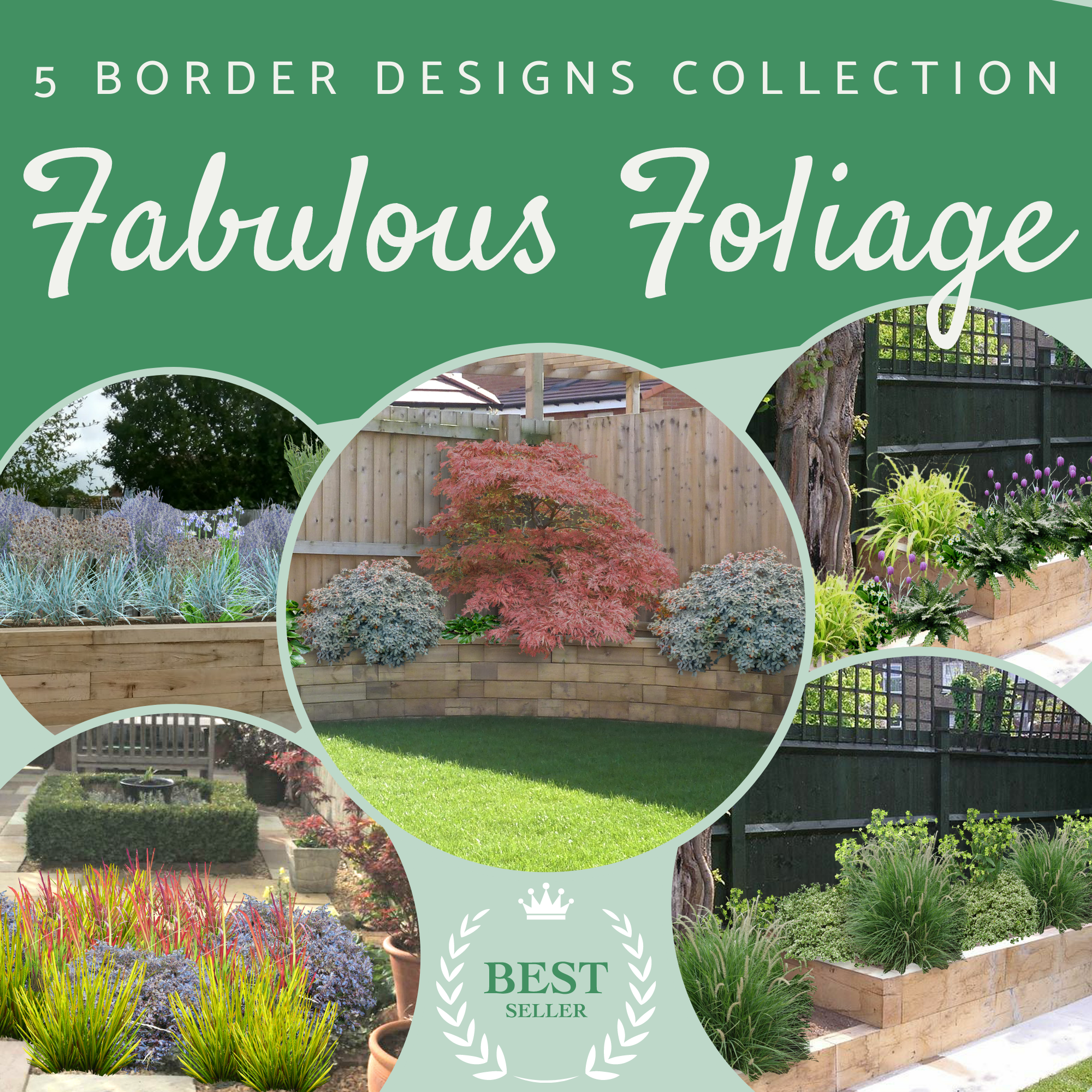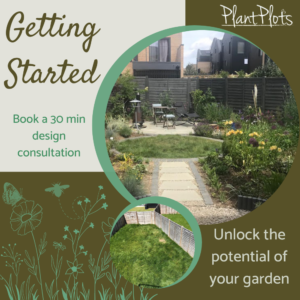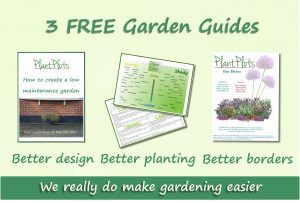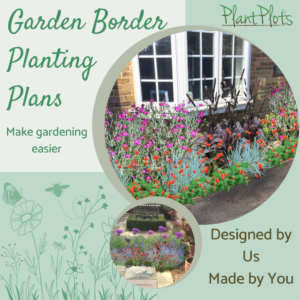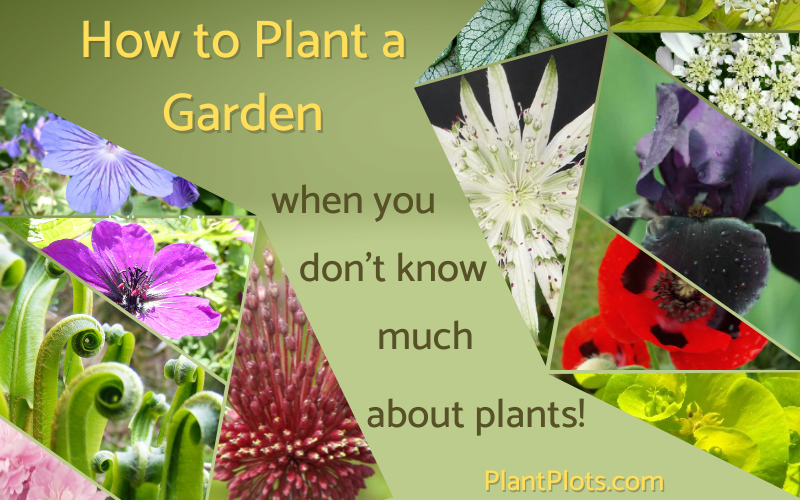
How to plant a garden
There is no real skill involved in planting a garden. In essence, all that is needed is a hole in the ground to plonk the plant in. Then you backfill with soil and water. It is really that simple.
However, there are 2 meanings to the phrase ‘how to plant a garden’. The physical part involves putting plants in the ground, but the second meaning is not really ‘how to plant’ it is instead ‘What to plant in a garden’.
How do you choose plants for the garden or pick a planting scheme for a border? Is there a magic design formula that helps plan a flower bed? And how can you plan a garden planting scheme; when you don’t know much about plants?
Use the buttons below to quickly skip to the section you want to read, watch our design videos or take a look at our ready made garden border ideas
How to plan a garden border
Let’s face it gardens are really all about plants.
We don’t walk into a garden and exclaim “ooh amazing patio” or “your garden path is to die for!” Instead, we walk around a garden looking at the plants, that is where the enjoyment lies. The problem most beginner gardeners face though is how can you plan a garden border when you don’t know much about plants.
Hopefully having read this; the science of garden border design and layout will seem less of an enigma.
So getting started, there are two elements involved in garden border planning; the shape and position of the border and secondly the plants used.
What shape should a garden border be?
I believe in providing you with a method and level of understanding of the design process to enable you to make changes to your own gardens. Now these methods aren’t necessarily how a professional designer would design, but that is not what you are trying to achieve.
You want to improve the look and function of your garden, by yourself, so my job is to help you understand what you need to know. Hence why I will not be writing about, form and flow and proportion because it is meaningless to most people.
Instead, I want you to think about big shapes.
The garden has several big shapes, the shape of the entire garden and the shape of the lawns, patio and shed shapes. Then the garden has smaller shapes, paths, borders and utility areas etc. Now when it comes to border design and planning, think about how that border impacts the big shapes in the garden.
Take this garden, for example, chipping into the rectangular shape of the lawn to ‘make a border’ will only make the shape of the lawn look messed up. Instead, you need to create the shape of the lawn and see what shapes the borders end up as.
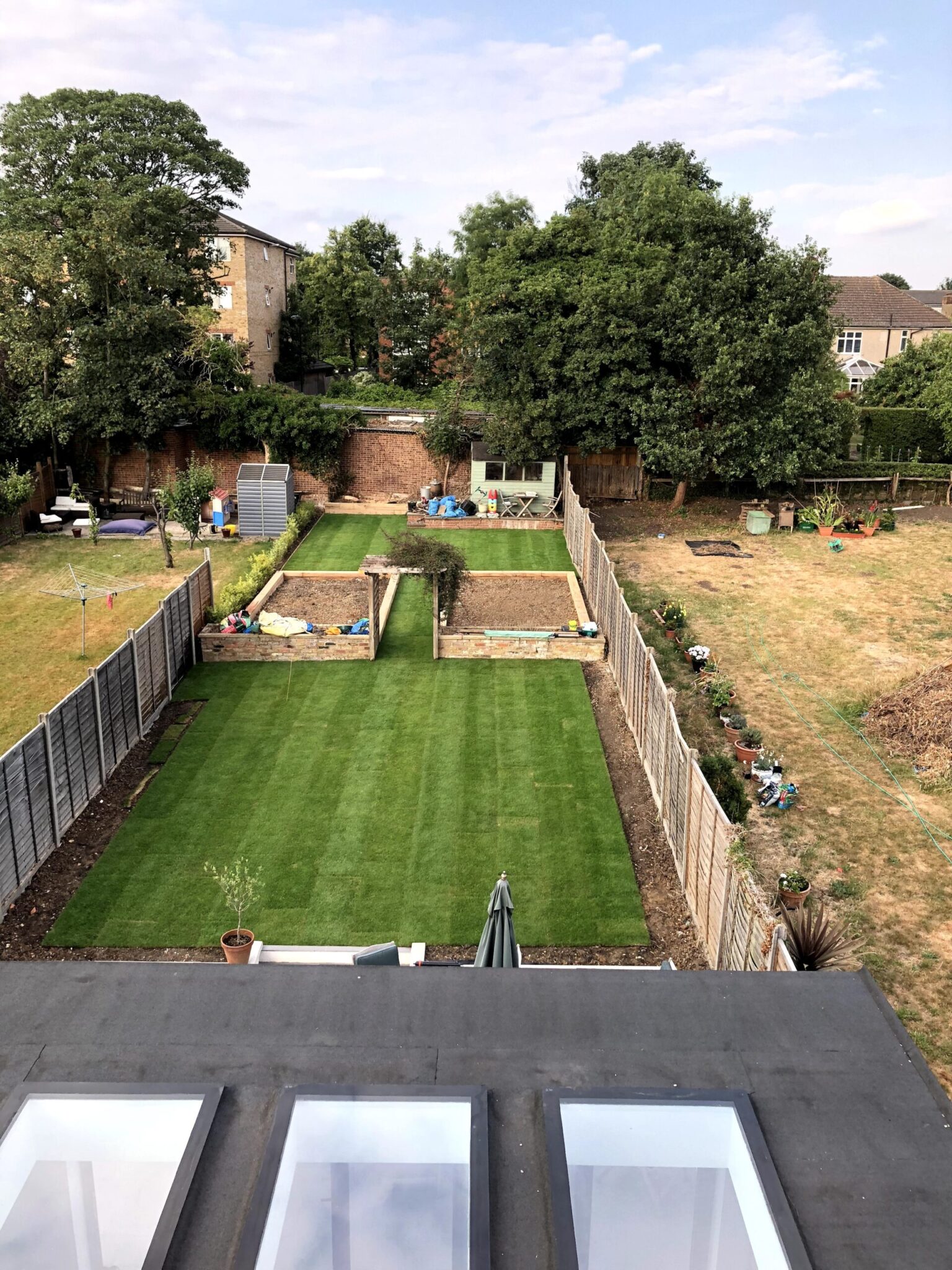
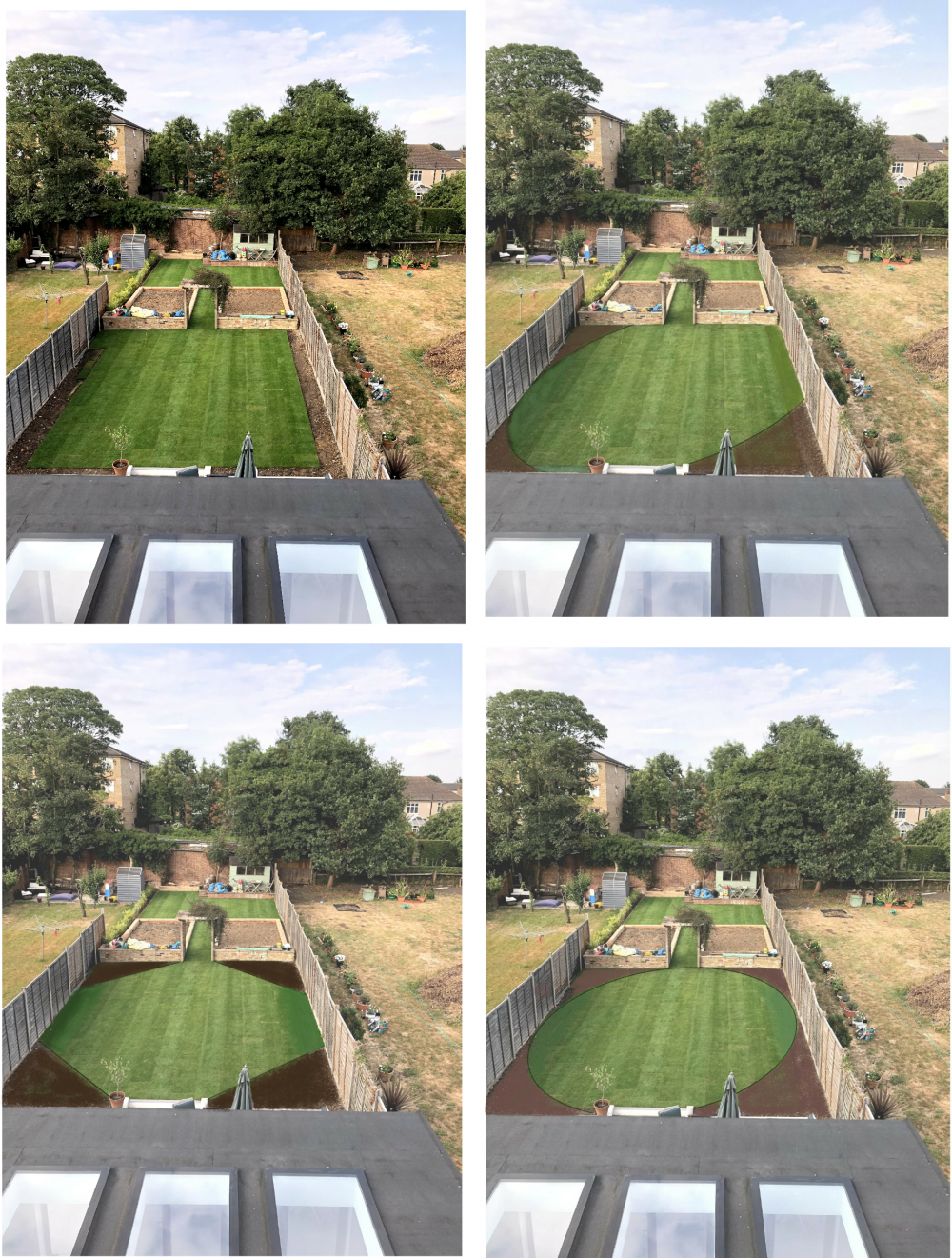
The second advantage of this method is that it creates bigger deeper borders. In the first image, the long narrow borders along the fences could only be planted in a long narrow way. The plants would stand side by side tracking the line of the fence.
If however, the lawn is turned or offset, the areas for planting become larger but the lawn will still feel a good size.
The starting point in how to plan a garden border is to not make one! The borders are simply the spaces left over once the big shapes are fitted in.
Planting a Border
It is nigh on impossible to begin to choose a planting scheme if a person doesn’t know much about plants. So what is needed is a method that can be used that will help that process. Fortunately, there is one you can use – now it will not create the style of planting seen in a show garden, but it will help you plan the border planting more easily.
Planting with Boxes:
In my book ‘I want to Like my Garden’ the back of the book has a whole section dedicated to boxes. If you know the space the plant will occupy it is easier to plan a planting look, because boxes are easy to fit together.
The border is a 3-dimensional space, so create a 3-dimensional scheme by using boxes.
To work out the number of plants just count the number of boxes.
Now, this is not a totally perfect system, but it is better than guesswork. This method will enable you to calculate the number of bigger plants you actually need to fill the space. The smaller plants and in-fills, like bulbs and ground cover plants, then fill up the spaces in between the bigger plants.
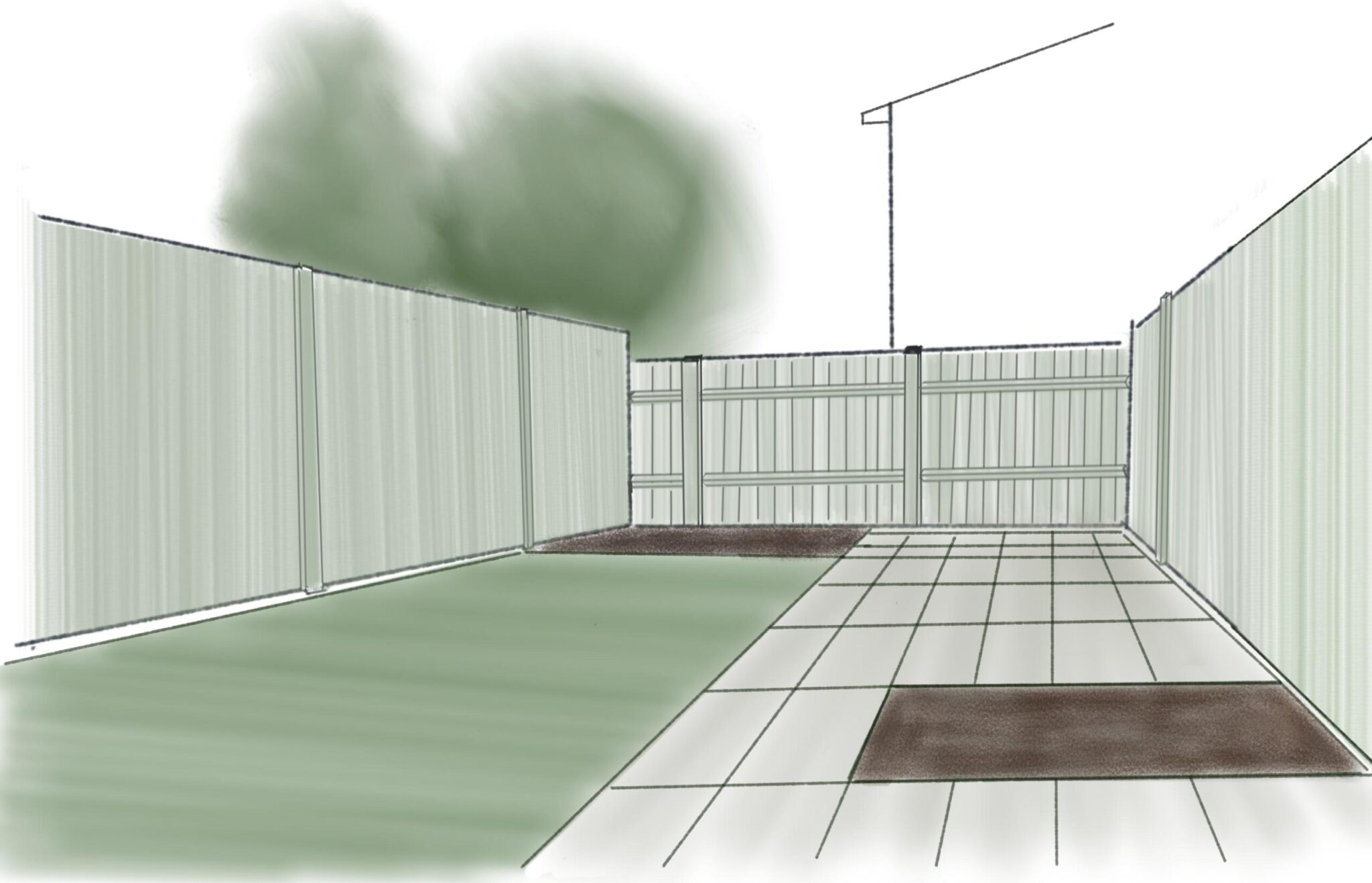
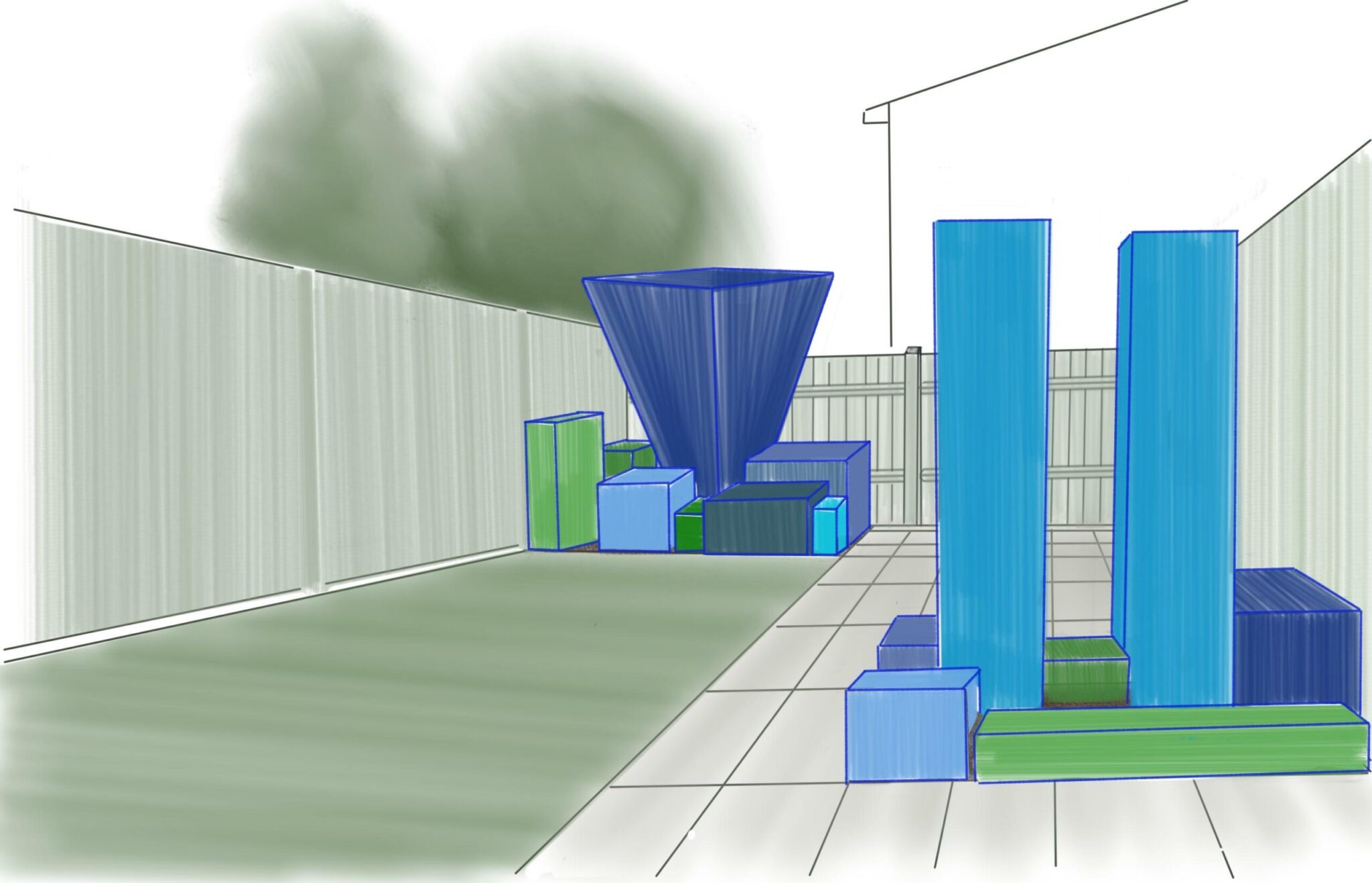

Designing stunning borders
A new garden design does not need to be expensive or involve a major overhaul of the garden. Transforming the overall look of the garden can just involve reworking what is already there. So how can you create a more stunning planting scheme?
There are 3 basic principles to follow:
- Create contrast with the surroundings
- Concentrate on the ‘out of summer’ plantings
- Think about synergy rather than similarity
So what does this mean?
How to create impactful borders
The world is full of beautiful and extraordinary gardens, some have been created by inspiring designers from Capability Brown through to modern designers like Piet Oudolf, and they do produce the most amazing gardens. Some gardens have been created by devoted horticulturalists and expert gardeners like Monty Don and others have been created by organisations such as the RHS for our collective enjoyment. All are packed with a cacophony of different and or exotic plant species; each garden showcases itself in a variety of ways. But what makes these gardens great?
The garden itself isn’t great, it is what the garden gives you that matters.
Now, this is the good bit and this is how you can make your garden border more beautiful too.
Whenever you are in any garden however big or small, you only ever occupy a small space. It is this space, at the time you are in it, that has to make you FEEL great! It does not then matter if you only have a tiny garden, because if you feel great in that space – your garden is doing a great job FOR YOU.
Using Contrast:
Small gardens are surrounded by big solid structures, walls fences, houses, pavements etc. In order to make your garden stand out, it needs to contrast with the surroundings. Instead of big green solid unmovable shrubs, think tall light skinny plants that move and sway with even the most gentle breeze.
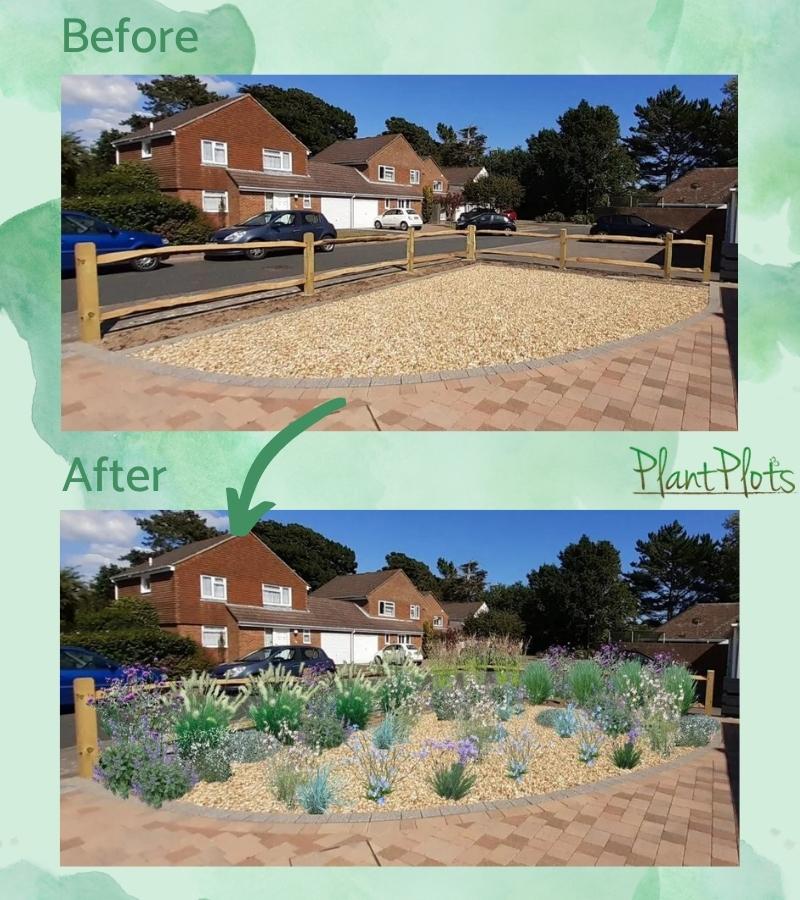
Think about the ‘off-season:
If the size of the border is small it needs to work harder. Simply filling it with plants that look amazing for 3 weeks but boring for the other 49 is no good.
Plan to pack as much in the border as possible, which flowering at different times of the year, then you always have something to look forward to. Bulbs are a perfect way to achieve this.
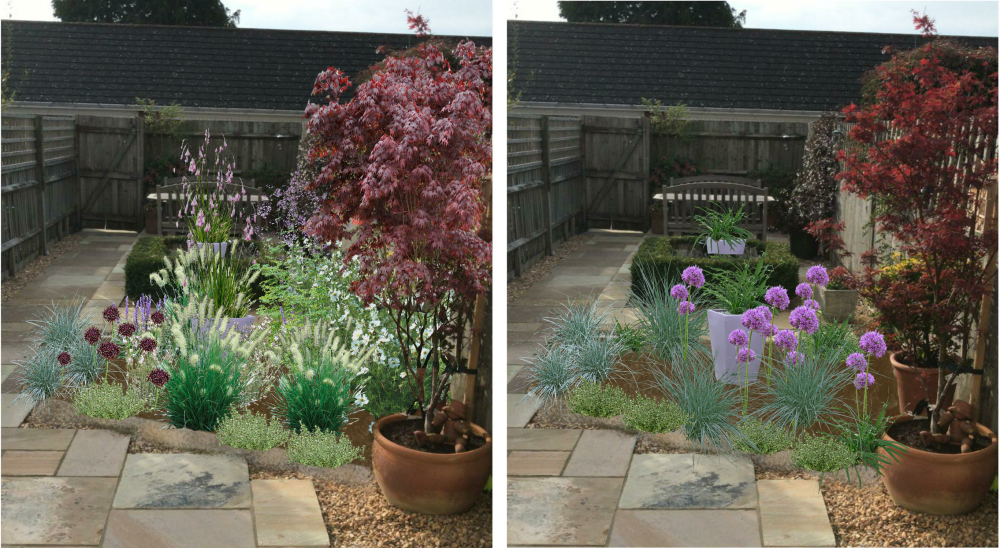
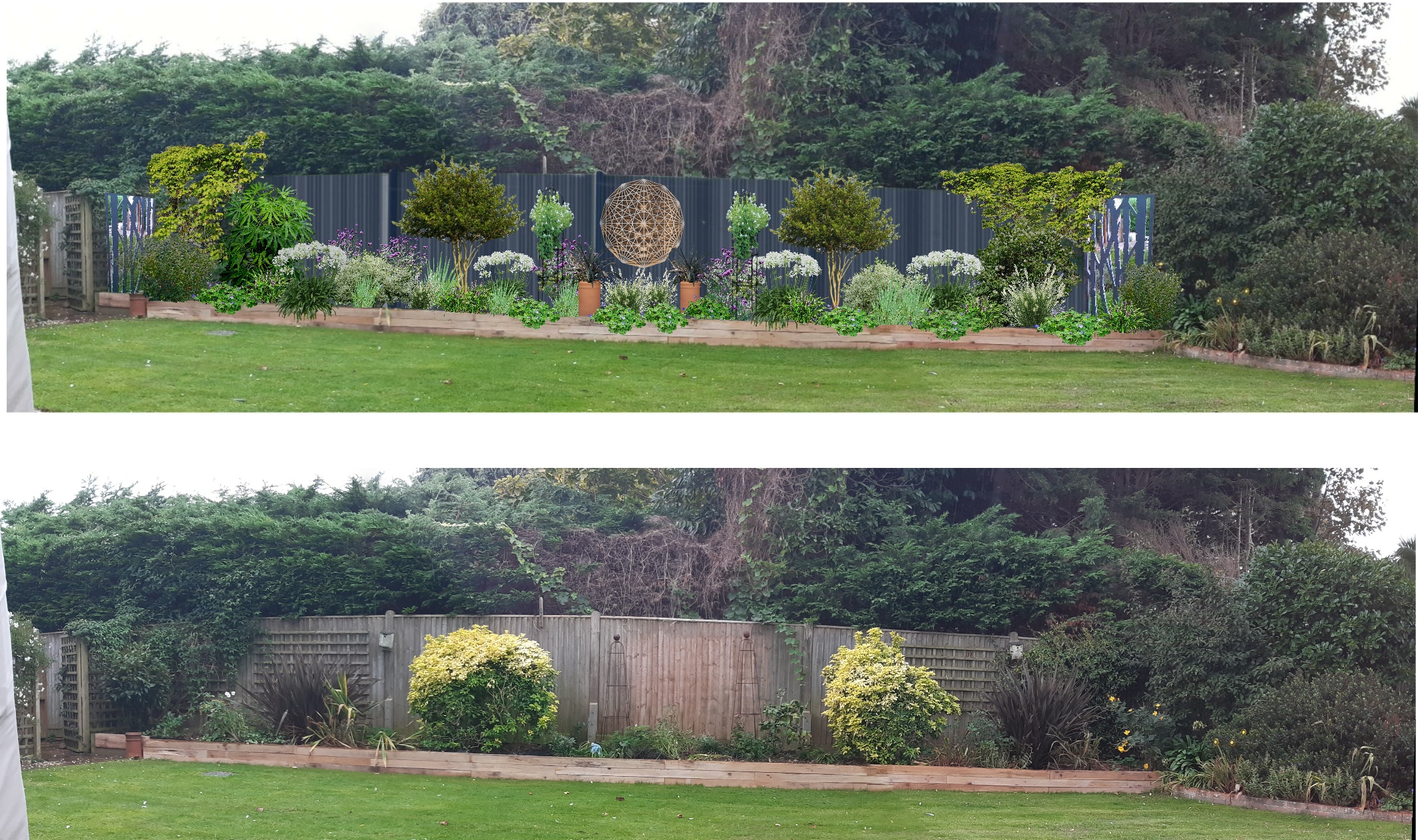
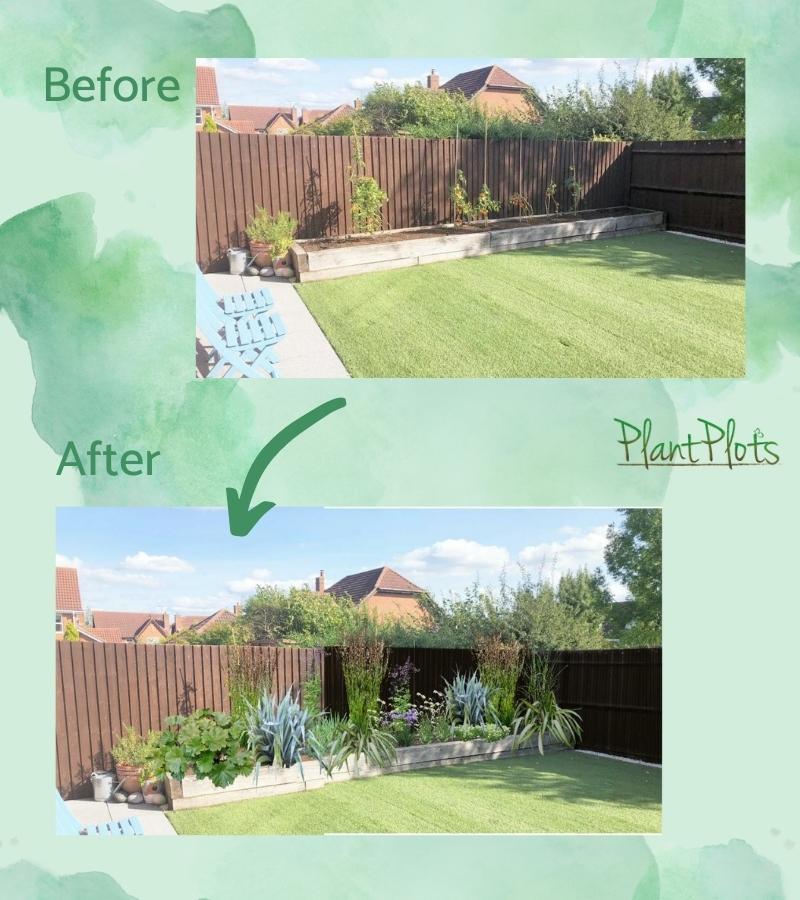
Synergy:
Creating impactful borders does not just rely on showy plants and flowers throughout the year, the borders need to look like they are part of the same garden too, not just plants plonked in a border here and there.
To achieve this when space is limited, use synergy.
- Ensure both borders have similar coloured flowers.
- Mirror the shapes of either the plants or the flowers.
- Use repeating colours or styles of pots for example
If there are similar things to look at in a garden, the plants and borders appear to link with each other. The whole garden appears more connected.
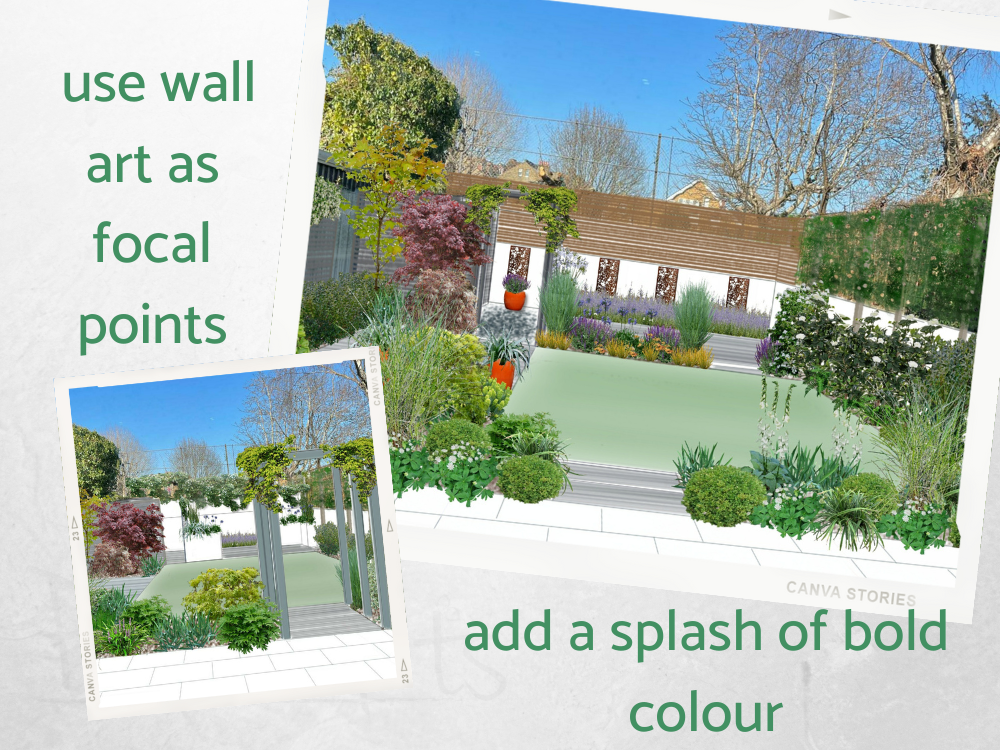
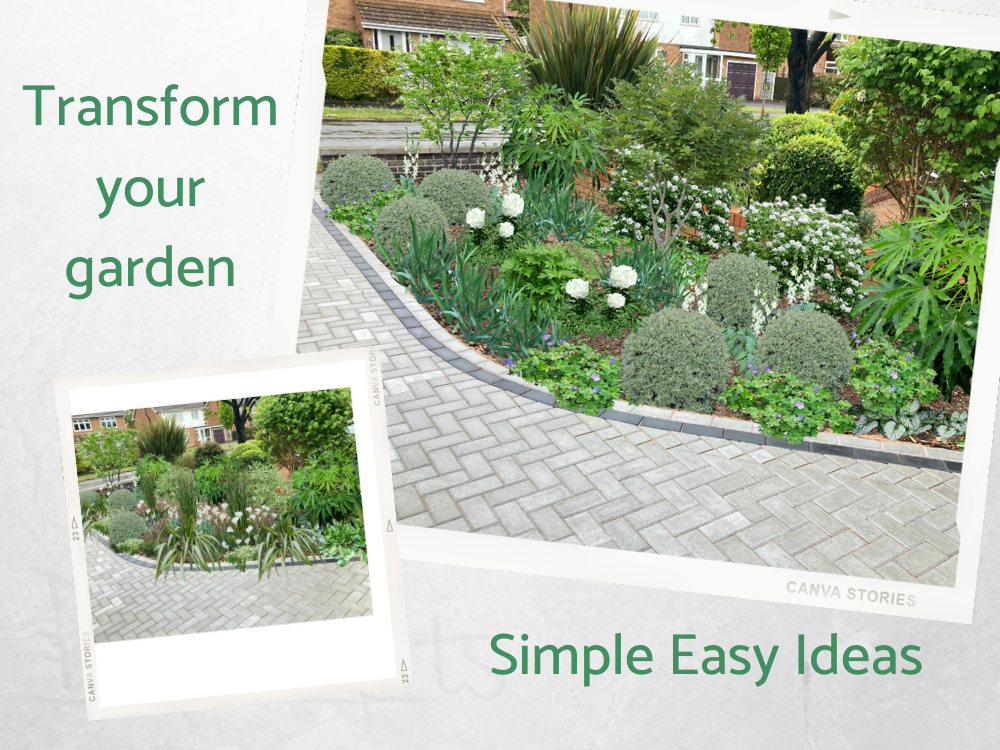
How to Choose Plants
For many gardeners choosing plants for the garden can be quite daunting.
How on earth can you work out if the Hellebores will grow well next to your Hebes?
There are two questions you need to ask when choosing a plant for the garden:
- WHAT DO I NEED THE PLANT TO DO?
- HOW DOES THE PLANT WANT TO GROW?
So for example, you have a sunny border beside the patio and you are looking for plants to grow on it. First and foremost, you need to understand the function the plant has to fulfil. In this case, the job description could be as follows;
- The plant must smell nice as it’s where you sit
- No spiky and prickly plants
- It needs to grow upright and not flop onto the patio
So now when you are in a garden centre, it becomes easier to choose the plant, because having seen one you think might be right, (scented, tactile and self-supporting), just check the plant label to see if the plant will behave itself where it’s going to be planted.
Check the size it will grow to, so it won’t outgrow the space or grow too tall.
Does the label say may need staking or phrases like ‘great for naturalising’ and ‘easy to propagate – both these mean the plant is good at spreading itself about. So maybe it’s not a good plant for next to the patio?
Best 50 plants for beginner gardeners
To help you get started, these aren’t the only plants you can have in your garden, but they are some of the easiest to get started with.
I would also add Roses to any list of don’t buy these if you want an easier garden. I know they are lovely and iconic British garden staples. However most of the time, Roses look less than iconic, suffering from black-spot and aphids.
These are high-maintenance plant divas. They will look great only IF you pamper, spray and mollycoddle them.
Have a Peony instead!
See also Planting in wet ground, windy gardens, seaside gardening, hanging baskets,
Why Bee-friendly Flowers are better for everyone
Domestic gardens are becoming far more important as mini-wildlife sanctuaries, and how and what plants you choose to use will have a massive impact on the benefit your garden delivers. Gardens ARE there to enhance your enjoyment of the world, but they can be so much more too. Choosing bee and butterfly-friendly flowers will create a garden that is not only good for you, it will be good for wildlife too.
And it’s not just bees you’ll attract either – lots of other insects will love coming to visit too.
If 80% of the plants in the garden attract pollinating insects or are good for wildlife, your garden can become a well-balanced biodiverse space you will enjoy being.
- Choose open flowers – so avoid doubles and overly cultivated blooms
- Avoid using Bedding plants
- Choose more natural-looking flowers and flower sizes
- Buy plants that flower in every season
- Use some native wildflowers in the borders too.
Think, who are flowers for?
Flowers aren’t just for us, many of today’s modern blooms, however, are created primarily to please the human eye – but are we forgetting who flowers are really for?
Let’s take you back a few hundred million years ago to when flowers began. The plants that survived and thrived were those that evolved the best strategy to reproduce effectively. The emergence of flowers and nectar allowed plants to attract insects and this improved the efficiency of the pollination process and allowed plants to proliferate.
Flowers evolved over millions of years to attract the best pollinating insects or they formed a symbiotic relationship with certain types of insects to develop a really efficient reproductive cycle. It created a win-win situation whereby flowers provided the insect with much-needed food and the insects took the pollen and redistributed it.
But horticulture has thrown a spanner in the works
For millions of years this system has worked well and then humans discovered how we could ‘breed’ bigger and better flowers. Careful selection and cross-pollinating meant we could create more colourful blooms. We could develop flowers with modified and elaborate petals and stamens and produce blooms in all the colours of the rainbow.
Horticulture also developed the ability to create more bountiful crops and fruits. We also managed to increase the range and variety of many hundreds of species of plants and thereby widen the available larder for many pollinating insects.
However, a whole industry has evolved to create flowering plants whose appeal and use to insects is pretty limited but to us humans they look spectacular!
These plants produce many flowers over long periods of time, often the flowers are bred to be larger and more elaborate and the colour combinations created are really quite astonishing.
Are these useful flowers though?
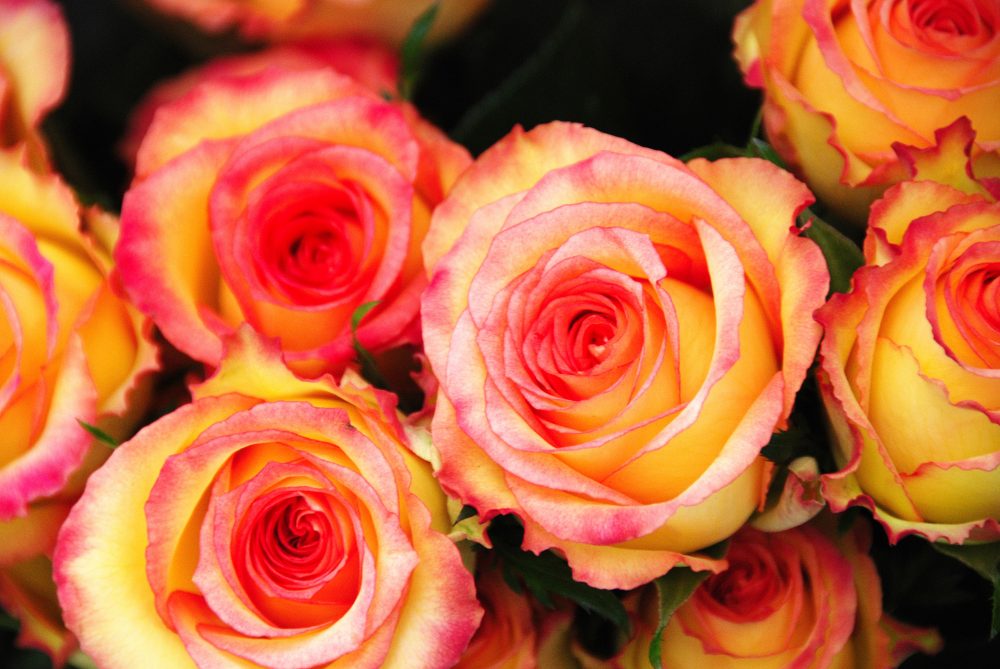
If a bee cannot recognise this as a flower…. aren’t we missing the point?
These plants have been cross-bred over time to create blooms that could never be created in nature. The stamens and petals are so modified, insects can’t access the nectar or transfer the pollen. The plant cannot reproduce itself. In fact, many of these plants are sterile and so cannot reproduce without human interference.
Thus if the flower produced is incapable of performing the function for which it originally evolved – is it really a flower?
Now you may argue that it doesn’t really matter. These plants can’t cross-pollinate with other plants and what’s the harm in planting them in the garden? Flip that thought process around and ask what’s the good of planting them in the garden either.
The problem arises if too many highly developed flowers appear in domestic gardens – bees and butterflies would expend so much energy trying to find food. They will have less food to store and this reduces their ability to survive the winters.
If we all try to do just a little bit…
Domestic gardens are becoming far more important to native wildlife than ever before. Do you really want to fill your gardens with plants that cannot provide any food for butterflies or bees?
All that is required is a little more thought before you buy any plants. If you go to a garden centre to buy your plants, have a look at the displays.
Do you see any insects flying around (now the Garden Centre could have sprayed the plants), but, with that concentration of plants in flower, you would surely expect to see some bees buzzing around.
It is quite possible, therefore, what you see as a spectacular flower is totally unrecognisable to a bee or butterfly.
A simple check on the plant label will normally tell you whether a plant is good for bees.
We all love to fill our houses with beautiful things. However, you wouldn’t buy a kettle that didn’t boil water just because it looked nice. Good design is about form AND function.
So before you buy plants for the garden, think about what benefits the plant will bring.
Bee Friendly Flowers for Winter & Early Spring
- Aconites
- Ajuga
- Berberis
- Calluna (heather)
- Crocus
- Dicentra
- English Bluebells
- Erica
- Galanthus (snowdrops)
- Genista
- Hellebores
- Ivy
- Lamium
- Lonicera Fragitissima (winter honeysuckle)
- Mahonia
- Muscari
- Primula vulgaris
- Pulmonaria
- Rosemary
- Viburnum
Bee and Butterfly Flowers for Spring:
- Allium
- Borage
- Campanula
- Celandine
- Chive
- Eryngium
- Foxglove
- Geranium
- Geum
- Hebe
- Honeysuckle
- Myosotis (Forget me not)
- Papaver
- Penstemon
- Salvia
- Thyme
Bee Friendly Flowers for Late Summer:
- Bergenia
- Cornflower
- Helianthemum (sunflowers)
- Kniphophia
- Lavender
- Loosestrife
- Nasturtium
- Raspberries (autumn cropping)
- Scabious
- Sedum
- Solidago
- Verbascum
- Verbena
- Veronica
What if butterflies could vote, would your garden win?
Who would benefit from the beautiful summer spectacle of fluttering butterflies more, you or your neighbours? One of life’s greatest pleasures is sitting in the garden on a warm summer day watching the daily hum of life. Bees buzzing in and out of flowers, ladybirds clambering up plant stems, butterflies and moths daintily balancing on petals to drink the nectar; our gardens are alive with life.
The biodiversity that inhabits these spaces is wonderful and should be enjoyed for the spectacle it is. So how would your garden fare? Will the butterflies vote with their feet and choose your patch and if not why not?
Did you know butterflies taste with their feet?
OK, it’s an interesting nugget of information, (butterflies taste flowers and leaves via sensors in their feet), and is a fact that may win you a point and team bragging rights in a pub quiz; but this is actually a really important piece of information that should govern HOW you garden.
Consider this; if you spray chemicals on the leaves and petals in your garden – what will they taste like then?
One would presume it’s pretty noxious, after all, it is meant to kill. The consequence though is that long after the pests have been destroyed, the flower is still useless. It still doesn’t smell or taste like a flower!
The butterfly can’t recognise the plant and so can’t feed, it’s possible the chemical residue could kill the butterfly too! That fabulous ‘kills all aphids in one easy application’ spray, has the unintended consequence of rendering your garden a lifeless desert; full of just perfectly formed leaves and petals.
Desiring a ‘perfect garden‘ is a false aspiration. It is impossible, plants will always be eaten by something, but plants are used to being eaten. If the munching of bugs was such a problem we would have all dies out by now.
I mention this, not because I want most gardeners to feel a sense of guilt about trying to keep the garden looking nice. I just don’t think many gardeners have ever really thought about the long-term consequences killing pests has. Most would be horrified to think of their gardens as toxic places for the very creatures they love watching.
So, what is the solution if you want perfect-looking plants, lots of bees and butterflies but no pests?
Unfortunately, if perfection is your goal as a gardener, you are going to be disappointed, there are no smart sprays that only kill unwanted pests. Chemical sprays simply kill all (or almost all) insects.
There is a solution, however, and it is one I have been writing about for some time now, which is to change what we think a perfect garden is.
You cannot have butterflies without caterpillars, so to view caterpillars as pests but butterflies as acceptable is daft. The problem however is not that caterpillars eat garden plants, it’s that we don’t think they should! Gardeners want plants to look perfect, but this aspiration is neither natural nor is it truly achievable.
It is an idea that has evolved from decades of images in books and magazines and TV programs showing how to grow and cultivate perfect plants.
Our understanding of what nature is has been warped by unrealistic imagery!
Nature doesn’t do ‘perfect’. Nature is a balancing act.
Albeit lovely, these plants could not look like this if left to grow by themselves. The role of Nature is a balancing act, hunters versus prey, the quantity of life versus the volume of a food resource. It is all balanced and juggled to ensure all life has a fair crack at the whip. The trouble is we mess it up because we interfere. We disrupt this balance.
Getting butterflies to vote for your garden is actually quite easy, and involves some very simple steps, what is more of an obstacle though is changing what you think your garden is for.
The simplest step to enjoying a butterfly-filled garden is to not spray anything at all.
Let Nature sort itself out. In the short term, you will find bugs becoming a problem but that is not because the bugs are the problem, it is because the garden is off balance.
This is the hard bit, though, some of your plants may succumb but this is Darwinism at work; the survival of the fittest. Some of your plants may look a bit bedraggled, but they will grow back. Over a couple of seasons, the lack of bug-munching predators will resolve itself. If the garden is overrun with bugs, more predators are attracted in and the balance is restored. All the gardener needs to do is be patient.
How can you attract more bees and butterflies into the garden though?
Bees, Butterflies and don’t forget moths, drink nectar, as such the simplest way to attract butterflies to your garden is to have lots of nectar-rich plants. There are loads to choose from and there are a few simple rules to follow when choosing:

These types of flowers will attract more bees, butterflies, moths and other beneficial insects, they may not look as showy or spectacular as some of the more modern hybrid plants many garden centres sell nowadays, but they are far better for your garden.
Gardens aren’t just for us and the show a garden puts on is more than just pretty eye candy for humans. The garden show is its biodiversity, it is what gardens are all about.
Think of your garden as the place where you can immerse yourself in the beauty of the world with a cup of tea in hand and worry less about being perfect.
That’s how you get butterflies to vote and that’s how your garden can win!
